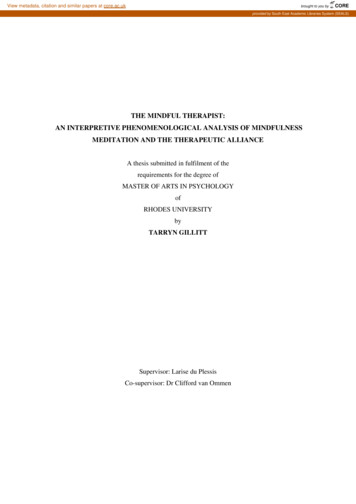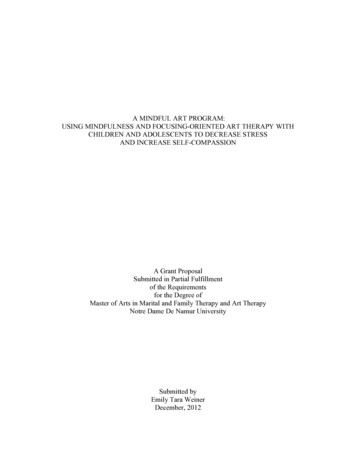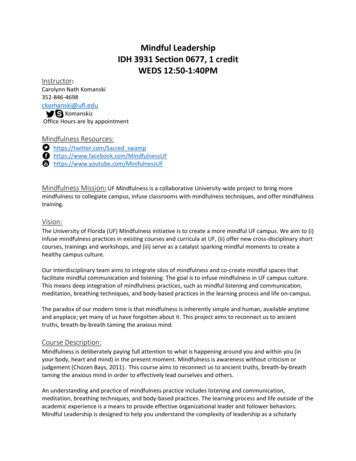
Transcription
View metadata, citation and similar papers at core.ac.ukbrought to you byCOREprovided by South East Academic Libraries System (SEALS)THE MINDFUL THERAPIST:AN INTERPRETIVE PHENOMENOLOGICAL ANALYSIS OF MINDFULNESSMEDITATION AND THE THERAPEUTIC ALLIANCEA thesis submitted in fulfilment of therequirements for the degree ofMASTER OF ARTS IN PSYCHOLOGYofRHODES UNIVERSITYbyTARRYN GILLITTSupervisor: Larise du PlessisCo-supervisor: Dr Clifford van Ommen
ABSTRACTThe aim of this study was to present and understand therapists’ experiences of the impactof their mindfulness meditation practice on their role in the therapeutic alliance. The topicemerged in response to extant research recommendations and researcher observations ofthe compatibility between mindfulness meditation outcomes and the demands ontherapists for establishing effective alliances with clients. The study adopted aninterpretive phenomenological analysis strategy located within the qualitative paradigm,and thus a small sample of therapists practicing mindfulness meditation were selected andinterviewed on their experiences using semi-structured interviewing. Data were analysedfor meaning units, which were then interpreted inductively and hermeneutically andcategorized into superordinate themes. Three superordinate themes within participants’experiences of how their mindfulness meditation practice impacts upon their role in thealliance were determined, namely: ‘self-care’; ‘insight into the structure of selfhood’; and‘immediate mindfulness meditation during therapy’. This study found these experiencescapacitated participants with compassionate interpersonal affects used for creating securebonds with clients; skills for accurate empathic understanding; and skills and attitudes forworking collaboratively with clients. Should future research confirm these findings,mindfulness meditation may be used as a tool to developed alliance formation abilitiesfor therapists in training. Importantly, findings from this project called for a morecomprehensive integration of theoretical positions on the construct of mindfulnessmeditation.ii
ACKNOWLEDGEMENTSMy sincere appreciation is owed to all those who offered their support, encouragementand guidance throughout the vast process of crafting this thesis.To my supervisors, Larise du Plessis and Clifford van Ommen, my thanks are owed toyou for your attentive care to my academic development and the invaluable knowledgethat you have imparted. Larise, your seemingly limitless warmth and wisdom havecontained me throughout this journey and the impact that you have had extends farbeyond that which is evident in this thesis.To the participants of this study, who gave so generously of their precious time, mygratitude is for your efforts involved in partaking in this study. It was a privilege to bewelcomed into your personal world, have you share your experiences with me and allowme the responsibility for representing them. I hope that justice has been awarded to theprofundity of your meditation practice and the meanings that it holds for you and yourwork as therapists.To those professionals in the health sector to whom I turned for direction when searchingfor participants, I thank you for your assistance. In particular I wish to thank you, Frieda,for going out of your way to ensure that this research was carried out. Your reality checkswere sometimes unnerving, but proved invaluable. I am especially appreciative of thehospitality that you gave me during the period of data collection.To my friends, landlords, neighbours, dogs and pigs, you are like family to me, and Ihave certainly demanded unconditional love from you. In your own ways, you have alloffered me spaces of refuge for the times when work became overwhelming and havecontinually sparked inspiration.Most importantly, my thanks go to my immediate family, whose support has never failedme. You have only ever expressed utmost pride, interest and genuine care towards myiii
pursuit of this goal. Whatever my needs were that arose, you saw to it that they weresatisfied. Whatever my mood, you listened. Thank you for providing me with thisopportunity and for helping me make it manifest.iv
TABLE OF CONTENTSTitle page .iAbstract .iiAcknowledgements .iiiTable of contents vCHAPTER ONE:AN INTRODUCTION TO THE STUDY 1CHAPTER TWO:THE THERAPEUTIC ALLIANCE:A LITERATURE REVIEW .82.1. Introduction . 82.2. Conceptualising the alliance: A context and definition .82.2.1. Pioneering notions of the alliance . .82.2.2. Contemporary understandings of the alliance . . 122.3. The therapists’ role in effective alliance establishment . 142.3.1. The demand for working collaboratively . .152.3.2. The demand for creating secure and empathic affective bonds .182.3.2.1. Congruence and authenticity .192.3.2.2. Unconditional positive regard .202.3.2.3. Accurate empathic understanding 212.4. Chapter summary .26CHAPTER THREE:MINDFULNESS MEDITATION:A LITERATURE REVIEW . 283.1. Introduction .283.2. Meditation .283.3. Mindfulness meditation in a Buddhist paradigm:Context, techniques, aims and outcomes . . 303.3.1. The technique of mindfulness meditation in Theravada Buddhism .303.3.2. The technique of mindfulness meditation in Middle Path Buddhism .31v
3.3.3. Aims and outcomes of Buddhist mindfulness meditation 323.4. Mindfulness meditation in clinical psychology:Context, techniques, aims and outcomes 373.4.1. The introduction of mindfulness meditation to the West . 373.4.2. The concept of mindfulness within psychology:A construct and practice . .383.4.3. Outcomes of mindfulness-based therapeutic practices:Contemporary research .413.5. Mindfulness meditation and the therapeutic alliance .443.6. Chapter summary .49CHAPTER FOUR: METHODOLOGY .524.1. Introduction . .524.2. Purpose of research .524.3. Research framework .524.3.1. Ideological orientation: Qualitative research 524.3.2. Research strategy: Interpretive phenomenological analysis .544.3.2.1. Philosophical underpinnings: Phenomenology 544.3.2.2. Philosophical underpinnings: Hermeneutics and intersubjectivity .564.4. Research design .614.4.1. Sampling .614.4.2. Data collection: Semi-structured interviewing .624.4.2.1. Interview design: Thematising .674.4.2.2. The ethics of interviewing . 684.4.3. Transcription .714.5. Data analysis .724.6. ‘Validity and reliability’ in the research .74CHAPTER FIVE:DATA RESULTS . .785.1. Introduction .785.2. Overview of participant narratives .78vi
5.2.1. Helen, Clinical Psychologist, Johannesburg .785.2.2. Larry, Clinical Psychologist, Johannesburg .795.2.3. Belle, Clinical Psychologist, Johannesburg .805.2.4. Loshini, Counselling Psychologist, East London . 815.3. Results 825.4. Analysis findings. . .835.4.1. Self-care . .835.4.1.1. Physical well-being .835.4.1.2. Occupational impairment prevention .845.4.1.3. Personal growth: ‘Doing the work yourself’ .875.4.2. Insight into the structures of selfhood .885.4.2.1. The self as interconnected 895.4.2.2. The self as multidimensional .925.4.2.3. The self as limited .965.4.3. Immediate mindfulness meditation during therapy . 965.4.3.1. Embodied empathy .985.4.3.2. Therapist presence .995.4.3.3. Mindful responding 1035.5. Chapter summary . 103CHAPTER SIX:DISCUSSION .1056.1. Introduction .1056.2. Self-care . 1056.2.1. Physical well-being .1066.2.2. Professional impairment prevention .1076.2.3. Personal growth: ‘Doing the work yourself’ .1106.3. Insight into the structures of selfhood .1116.3.1. The self as interconnected .1146.3.2. The self as multidimensional .1176.3.3. The self as limited .1226.4. Immediate mindfulness meditation during therapy 123vii
6.4.1. Embodied empathy .1256.4.2. Therapist presence .1276.4.3. Mindful responding .1306.5. Chapter summary .131CHAPTER SEVEN: CONCLUSION .1337.1. Introduction .1337.2. Overview of the study .1337.3. Summary of findings .1347.4. Implications of the study and recommendations for future research . 1357.5. Limitations of the study .137REFERENCE LIST .139APPENDICES 162Appendix I: Interview schedule . 162Appendix II: Consent form . . 164viii
CHAPTER ONEINTRODUCTIONPsychotherapy can be understood in broad terms as an institutionalized practicecomprised of various processes that seek to guide changes within the underlyingpsychological organization of an individual (Bugental, 1992; Corey, 1996; Pear,2007) This understanding is a partial one, however, as the field of psychotherapyencompasses numerous theoretical orientations, each with their own epistemologiesand subsequent methods.These differing approaches lead to nuances withinpsychotherapeutic practice, such as the setting of specific therapeutic goals, thetechniques that are utilized, the kind of focus placed on the experiences of the client,and differences in the function and role of the therapist (Corey, 1996; Egan, 1990).The goal of therapy, regardless of its theoretical orientation, is, nonetheless, that ofrealising a positive outcome for the client.Research shows that although psychotherapy has been effective (Lambert & Bergin,1994; Lambert & Ogles, 2004), not all clients benefit from psychotherapy. Thissuggests that there are particular mechanisms of client change within and betweentherapies (Johansson & Høglend, 2007). However, because of the diversity ofpsychotherapy, identifying the underlying mechanisms responsible for change hasproved to be somewhat of a difficult task (Baldwin, Wampold & Imel, 2007).Mechanisms of change may pertain to a particular technique used, or a specificdisorder targeted – aspects that are determined by the theoretical framework.However, meta-theoretical mechanisms of change have been identified, these beingmechanisms that are relevant to all schools of psychotherapy. This group ofmechanisms allows us to speak generally of psychotherapy and understand essentialand necessary components of therapeutic processes – not to reductively homogenizepsychotherapy by any means, but to establish some sort of unitary framework forunderstanding psychotherapy and how it can produce positive outcomes for the client.The therapeutic relationship – the relationship that exists between a client and theirtherapist – has been one of the most studied meta-theoretical mechanisms of clientchange (Horvath & Bedi, 2002). Brent and Kolko (1998, p. 17) have definedpsychotherapy as:1
a modality of treatment in which the therapist and patient(s) work together toameliorate psychopathologic conditions and functional impairment throughfocus on the therapeutic relationship; the patient's attitudes, thoughts, affect,and behaviour; and social context and developmentengagement between twoindividuals, namely the therapist and the client, who are focused on bringingabout change within the client via the therapeutic relationship.However, the degree of emphasis placed on the value of the therapeutic relationship,as a tool for predicting outcomes, differs from orientation to orientation. Withinpsychoanalysis the relationship is regarded as “the primary vehicle of change” (Beach& Power, 1996, p. 1). Other perspectives, such as cognitive and behavioural therapies,have explored the client/therapist relationship, but to a lesser degree, focusing insteadon the techniques that are employed (Beach & Power, 1996). A polarized debate hasensued – is the relationship curative in its own right, or is it merely facilitative ofother therapeutic processes? While it is yet to be resolved whether the relationship isboth a necessary and sufficient condition for realising positive outcomes, it isgenerally agreed that the relationship is at least necessary, and functions as the contextwithin which all the various other psychotherapeutic processes can occur.AsKemplar (cited in Teyber, 2006, p. 302) explains, the principle of engaging, of moving toward or in relation to another, is theessential principle in common [across therapeutic orientations] – essentialbecause it is only in the context of one another that the possibility for changecan live.Kemplar’s statement indicates that it is only through the interaction between therapistand client that therapy can be undertaken.Safran, Crocker, McMain and Murray (1990) argue that therapeutic techniques are notdisembodied processes that exist separately from this interaction, but are essentiallyembedded within it. Within the relationship between client and therapist,psychotherapeutic processes take on meaning (Safran et al., 1990; Safran & Muran,2000), which contributes to their complexity and efficacy (Butler & Strupp, 1986). In2
sum, the therapeutic relationship is a central component of all psychotherapies, andneeds to be understood in detail for it to maximize positive client outcomes.In an effort to better understand its nature and processes, theoretical examinations ofthe therapeutic relationship have been undertaken by numerous scholars. Scholarssuch as Bordin (1979), Freud (1958), Greenson (1976) Zetzel (1956), and playedparticularly seminal roles in establishing the theoretical framework of this debate.Based on initial theories postulated by Freud, these examinations have uncoveredthree interrelated components of the therapeutic relationship, namely: the ‘real’relationship; a transference component; and the working or therapeutic alliance(Bordin, 1979; Gelso & Hayes, 1998; Teyber, 2006; Zack, Castonguay & Boswell,2007). The therapeutic alliance is defined in this study as the collaborative,interpersonal relationship that is formed between therapist and client; a relationshipwhich is based on a secure and empathic affective bond, and which is the meanswhereby an agreement is reached on the specific tasks and goals that will realisesuccessful therapeutic outcomes.The therapeutic alliance has been cited as the most significant variable of any processto-outcome relationship across all theoretical orientations of psychotherapy (Norcross,2002; Wampold, 2001). This means that much of the efficacy of the therapeuticrelationship as a change mechanism can be attributed to the role played by thealliance. In theory, an effective alliance is one that meets the conditions that willultimately foster a positive therapeutic outcome for the client.The second chapter of this study is a theoretical examination of the construct of thetherapeutic alliance. The chapter briefly traces the history of the alliance and itsemergence in the field of psychotherapy as a meta-construct, arriving at anoperational definition. The primary features of the alliance are explored, namely (i)collaboration, and (ii) the secure and empathic affective bond that is formed betweentherapist and client.Chapter Two goes on to propose that the alliance is itself a differential variable ofoutcome, meaning that its quality is neither a given, nor is it constant. This entailsthat the alliance can hold various causal positions in relation to therapy outcome,3
depending on the extent to which the conditions of the alliance are satisfied(Johannson & Høglend, 2007). Both therapist and client construct the relationship,each with their own skills, characteristics, personality and history (Gelso & Carter,1994), and so in effect, no two therapy dyads are the same (Kieffer, 2007), and no twoalliances are the same. This research is primarily interested in the role of the therapistin establishing the alliance. Chapter Two attempts to explicate the therapist’s role, byexamining the demands placed on therapists if they are to meet the conditions of aneffective alliance.This inquiry was first motivated by the identification of compatibility between, on theone hand, the demands placed on therapists for effective alliance formation, and, onthe other, the outcomes of mindfulness-based practices. For example, two of thedemands on therapists that are identified in Chapter Two are therapist presence andnon-judgment. Simply defined, mindfulness-based practice is awareness of andattention to present-moment experience, coupled with an accepting and nonjudgmental attitude (Epstein, 2007; Kabat-Zinn, 1994). Thus, it is immediatelyapparent that non-judgment and presence are common features to both mindfulnessbased practice and therapist demands for effective alliance formation.Further reading into the topic of mindfulness-based practices revealed that traditionalBuddhist mindfulness practice – that is, insight (vipassana), or mindfuness meditation– is used to cultivate an experience of anatta, or ‘no self’ (Gilpin, 2008), andshunyata, meaning ‘emptiness’ (Novick, 1999). Both of these experiences areperceived within Buddhism as cultivating a more compassionate way of beingtowards others (Sri Dhammananda, 2002) – they are thought to foster a favourableattitude of kindness, tenderness and understanding, grounded in the ability to perceiveand experience equality with all sentient beings (Hopkins, 2001). A compassionatedisposition is clearly advantageous for therapists in the context of establishing secureand empathic affective bonds with their clients.In addition to these observations, there exists a small but encouraging body ofresearch concerning mindfulness-based practices, including mindfulness meditation,amongst therapists. These studies have revealed numerous positive outcomes,including reduced stress and subsequent increases in attention (Shapiro, Brown &4
Biegel, 2007); increased self-compassion (Shapiro et al., 2007); increased clarity ofthought and capacity for reflection (Schure, Christopher & Christopher, 2008); andexperiences of a greater capacity for empathy and compassion (Schure et al., 2008).The authors of these studies have linked several of the abovementioned outcomes toan increase in ability on the part of therapists to form effective relationships with theirclients, and have recommended that future researchers pursue this topic further.However, despite such links being explicated, and despite the recommendations forfurther research, studies looking directly at the impact of mindfulness-based practiceon therapists’ ability to form effective relationships with their clients have not yetbeen conducted, as far as the researcher is aware. This research aims to fill this gap inthe literature and to respond to those recommendations for further study, by lookingspecifically at the alliance dimension of the therapeutic relationship.Chapter Three will explore the links between the demands placed on therapists forestablishing effective alliances and some of the known outcomes of mindfulnessbased practices in greater detail. This exploration will be located within the discourseof mindfulness, thus Chapter Three begins with an examination of mindfulness as aconstruct and also as a practice. Beginning with a review of Buddhist mindfulnessmeditation and moving to the application of mindfulness in the context of Westernclinical psychology, this chapter attempts to present a rubric for understandingmindfulness-based practices, particularly mindfulness meditation, in terms of theirconceptualizations, processes and their effects. The different paradigms within whichmindfulness is situated will be shown to have implications for how the aims andoutcomes of mindfulness-based practices are interpreted.The extant literature on mindfulness, the alliance, and on some of the effects ofmindfulness-based practices on therapists’ relationships with their clients, clarifies theresearch problem and, simultaneously, provides a theoretical framework forunderstanding participants’ experiences. However, because the subject has not beendirectly researched before, and because the construct of mindfulness remainsconceptually unresolved (Gilpin, 2008; Kotanski & Hassed, 2009), this framework is(at least at present) unsophisticated.5
The limitations of the theoretical framework point to the need for theory building,rather than theory falsification. In order to meet this need, a qualitative approachtowards designing the research was selected. The adoption of a qualitative approachalso fills a gap within the field of mindfulness-based practices, as the majority of itsresearch thus far has come from an empirical, positivist perspective, thus there is littledepth to these descriptions of mindfulness-based practices.Chapter Four explores the key features of the qualitative design employed in thisstudy. The chapter begins by presenting the study’s primary objectives – (i) tounderstand the experiences and meanings of therapists regarding the impact of theirmindfulness meditation practice on their role in the therapeutic alliance, and (ii) tobuild theory on this topic. Chapter Four goes on to present the design of this research.It shows that an interpretive phenomenological analysis (IPA) strategy was deemedthe most appropriate to meet the research objectives, because the IPA design aims toexplore how participants make sense of their personal and social worlds (Smith &Osborn, 2003). The IPA strategy is grounded in the philosophies of phenomenology,hermeneutics, and interpretation. The ontological assumptions underpinning thesephilosophies, and their epistemological implications for research design, are describedand discussed.Chapter Five of this study details the results of the research and presents the findingsof the data analysis procedure. Summaries of participant accounts are presented forthe purpose of contextualising the results and analysis to follow. Three superordinatethemes emerged from analysing the collected data, and they are presented along withtheir respective sub-themes in a tabulated format. The themes are as follows:Table 1:Presentation of data themes1.Self-care1.1. Physical well-being1.2. Occupational impairment prevention1.3. Personal growth: ‘Doing the work yourself’2.Insight into the structures of selfhood2.1. The self as interconnected2.2. The self as multidimensional6
2.3. The self as limited3.Immediate mindfulness meditation during therapy3.1. Embodied empathy3.2. Therapist presence3.3. Responding mindfullyChapter Five includes a description of each theme, an explanation of the researcher’sprocess of interpretation, and a presentation of detailed excerpts from the participants’accounts.The research results are further discussed in Chapter Six, where the participants’accounts are theoretically contextualised. This is achieved by relating them to thediscourses of mindfulness and the therapeutic alliance.Chapter Seven concludes the study, providing an overview of the project, a summaryof the main findings and a reflection on their implications for future research into thetopic. The limitations of the study are also discussed.7
CHAPTER TWOA LITERATURE REVIEW: THE THERAPEUTIC ALLIANCE2.1. IntroductionThe primary aim of this study is to explore therapists’ experiences and meanings ofhow their mindfulness meditation practice impacts upon their role in effective allianceformation. The following chapter serves to conceptualise the therapeutic alliance, andthe role of the therapist in establishing it. A theoretical context for this construct isprovided, which traces the development of the alliance from its emergence in earlypsychoanalytic theory to its becoming, due to its consistent correlation to therapyoutcomes, a meta-theoretical construct relevant to all orientations of psychotherapy.From this context, the primary features of a theoretically ideal alliance – that is, analliance that yields positive therapeutic outcomes – are identified. These features are(i) collaboration and (ii) the forming of a secure and empathic affective bond betweentherapist and client. Based on these features, an operational definition of the allianceis developed. The chapter goes on to explicate the importance of the role of thetherapist in establishing the alliance. The therapist’s role is explored by looking at thedemands placed on therapists by the need to work collaboratively and to create secureand empathic affective bonds with their clients.2.2. Conceptualising the alliance: A context and definition2.2.1. Pioneering notions of the allianceSince the advent of psychoanalytic psychology, the therapeutic relationship has beenprioritized as a factor explaining client change (Johnson & Wright, 2002). Freud’s(1958) focus on the concept of transference – where the unconscious impulses anddesires of a client are projected onto the therapist during therapy – resulted in effortsto more thoroughly understand the therapeutic relationship within which thistransference occurs (Johnson & Wright, 2002). Freud believed that transference wasan unrealistic component of the relationship, fuelled by the client’s neurosis(Saketopoulou, 1999), and often manifested as resistance towards therapy, or a refusalto change (De Mijolla, 2010). In dealing with this resistance, Freud recognized thenecessity to form an “analytic pact” with the client (De Mijolla, 2010, p. 1), where thetherapist appealed to the client’s desire to heal, and encouraged them to allythemselves with the therapist to work against their neurotic aspects (Saketopoulou,8
1999). The pact formed with a client was differentiated from the negative transferencecomponent of the relationship, and viewed as constituting the positive, reality-basedcomponent of the relationship (Saketopoulou, 1999). This reality-based componentformed the basis for developing the concept of the therapeutic alliance, although theterm itself was not introduced until 1956 by Elizabeth Zetzel (Saketopoulou, 1999).Prominent psychoanalytic theorists, namely Richard Sterba (1934), Edward Birbring(1937) and Zetzel (1956), went on to expand Freud’s initial ideas about forming apact with the client. Zetzel’s theory, in particular, has greatly influencedcontemporary views of the alliance. Zetzel proposed that in order to work with thehealthy and functional aspects of the client’s ego, the client needed to perceive theanalyst as being helpful (Saketopoulou, 1999). She theorized that analysts, byacknowledging the difficulties of the client’s situation and offering supportivecomments, could encourage this perception, and form a therapeutic alliance with theirclients (Saketopoulou, 1999). She likened the attitude that the analyst adopts towardtheir client to that of a mother towards her child (De Mijolla, 2010). This parallel,between the relationship of mother and child and the relationship of therapist andclient, has since undergone extensive development within the field of attachmenttheory (Angus & Kagan, 2007).Attachment theory is primarily concerned with the affective bond that forms betweena child and their primary caregiver (Sonkin, 2005). John Bowlby (1969) theorised thatin its infancy, the child is entirely dependent on their primary caregiver, and that thedevelopment of a behavioural system of attachment between these two figures is anecessary evolutionary function that ensures the infant’s survival (Sonkin, 2005). Theattachment figure – the primary caregiver in this instance – is responsible for meetingboth the infant’s physical and psychological needs. The infant’s development islargely dependent on the caregiving style, within which specific affects of thecaregiver play an important role (Senior, 2002). Attachment theorist Harry Harlow(1958) conducted controversial experiments on neonatal and infant macaquemonkeys, with the aim of identifying attachment variables. Harlow presented dataidentifying a correlation between adaptive behaviour and the quality of attachmentbetween the infant and the primary caregiver. The infant monkeys achieved security9
(evident through exploratory behaviour and lowered fear responses to stimuli) throughpresence, consistent contact, warmth and nurturing behavior from the caregiver.Similarly in human populations, attachment theory proposes that an infant is able tobecome progressively more independent, and to explore their surroundings, if there isa secure attachment with the attachment figure (Ainsworth, Blehar, Waters & Wall,1978). Bowlby (1969) proposed that through sensitive and emotionally availablecaregiving, a secure base is formed that provides the infant with a sense of protection,enabling them to engage in ex
THE MINDFUL THERAPIST: AN INTERPRETIVE PHENOMENOLOGICAL ANALYSIS OF MINDFULNESS MEDITATION AND THE THERAPEUTIC ALLIANCE A thesis submitted in fulfilment of the requirements for the degree of MASTER OF ARTS IN PSYCHOLOGY of RHODES UNIVERSITY by TARRYN










